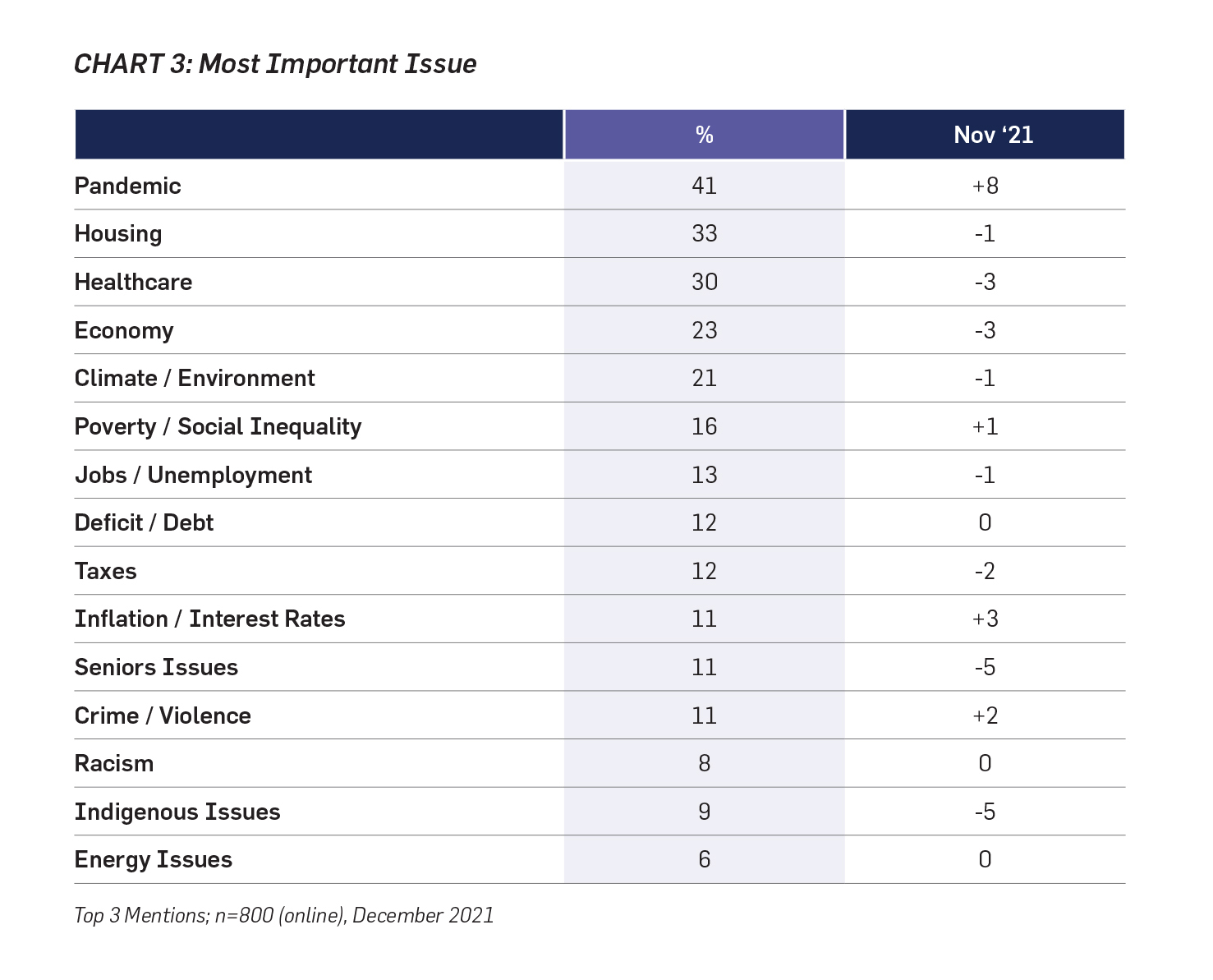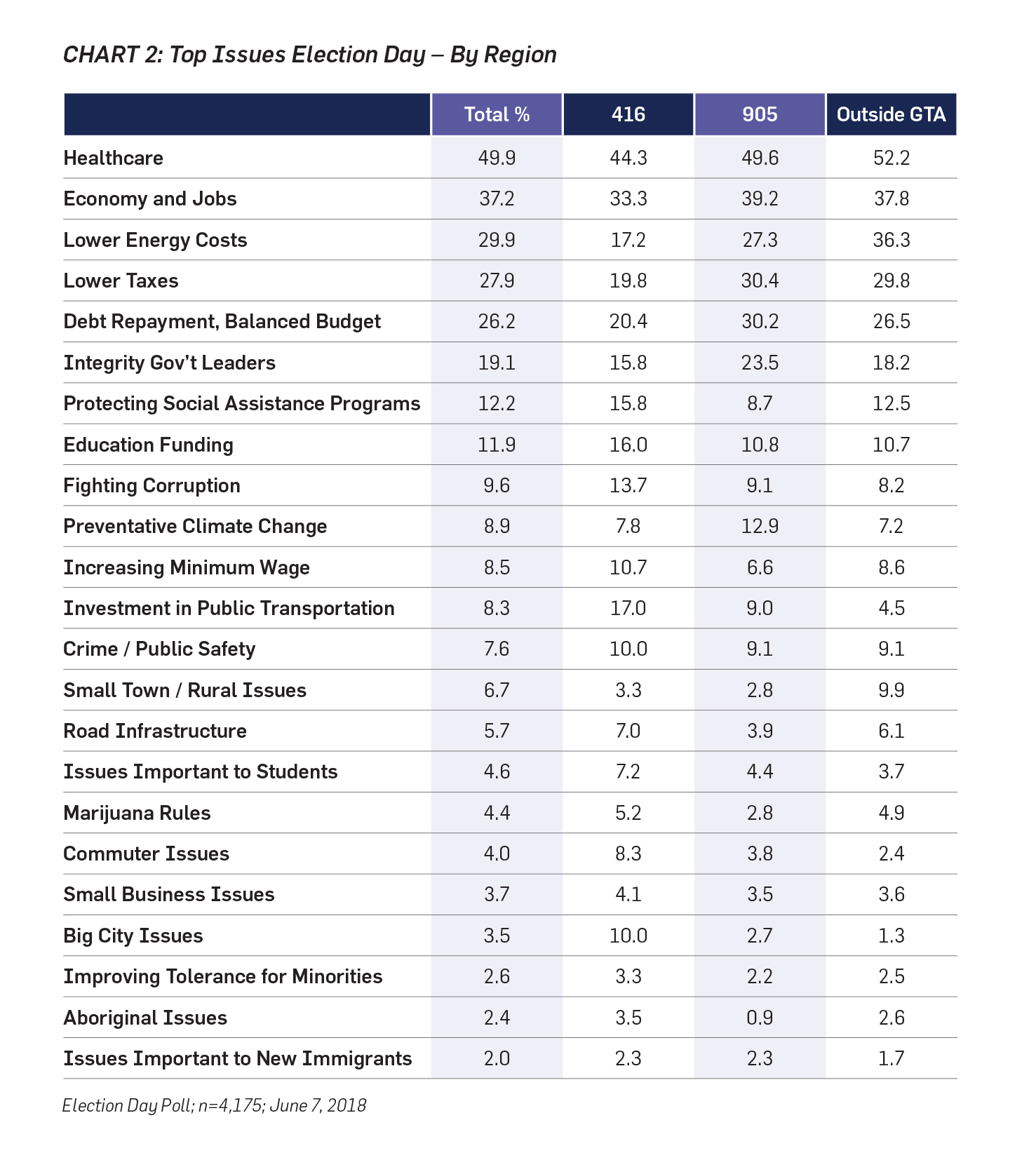Policy Papers
Ontario 360 Transition Briefings 2022: The Issues That Will Drive The Next Ontario Election
Darrell Bricker defines what this election's 'ballot issues' will be by region and how our parties could position themselves to win

Darrell Bricker, Ph.D.
Global CEO, Ipsos Public Affairs
Senior Fellow, Munk School of Global Affairs and Public Policy
Senator Keith Davey, who was famous for being Prime Minister Pierre Trudeau’s election “rainmaker,” used to say – “the most important task in any election is to find an issue and make it your own”. What he meant by this is that successful campaign teams don’t spend their precious resources fighting over issues that won’t win them the election. They focus on issues that are priorities for the electorate and offer them the opportunity to differentiate from the other parties.
The party that does the best job of following Senator Davey’s advice defines what political pros call the “ballot question.” The ballot question is what a winning party wants their universe of voters to be thinking about when they mark their ballot on election day. In other words – “I’m voting for candidate X because they will do the best job on Y issue if they are elected.”
There are two approaches to developing a ballot question. The first is to seize an issue the electorate already has as a top concern and to present your party’s solution as the most viable option. For example, if the most important issue for voters is unemployment, then the party best able to separate themselves from the pack by having the preferred jobs plan should also have the best chance of winning the election.
This approach doesn’t always work out because sometimes the most important issue doesn’t create partisan differentiation. Healthcare is a good example of this. For many years healthcare has topped the charts as Ontario’s most important issue but none of the major parties were seen to have the best approach to managing the system.
The second approach is when a party is already clearly identified as the leader on an issue that’s less salient to voters. Then the job of the campaign team is to make the issue more important. This is the change the channel, turn up the volume strategy. A good example of this is what the Liberals and their leader Kathleen Wynne tried to do with the minimum wage issue in the last Ontario campaign. Polling at the time showed the Liberals leading on minimum wage but also that voters didn’t care much about it. The Liberals thought they had a wedge issue to use against Ford and the Tories, but it turned into a damp squib. The minimum wage remained a low priority issue throughout the campaign and had little influence on the election outcome.
Charts 1 and 2 provide additional insight on how voters ranked issues in the 2018 election campaign. These data are taken from Ipsos’s online Election Day poll conducted on behalf of Global News. These data are taken from online interviews on Election Day with actual voters as opposed to the general population or likely voters.
Chart 1 shows why the Progressive Conservative Party and Doug Ford were so well positioned with Ontario voters in this election. There is close alignment between the issues that were most important to voters and the perceived strengths of the PC Party. The one exception was healthcare which was a higher priority for Liberal and NDP voters than it was for Conservative voters. As stated earlier, there needs to be more partisan differentiation than shown here for an issue to play a significant role in an election. Experience shows that healthcare tends to play a role in election campaigns only when a leading political party is seen to be a major threat to the future of the system. That wasn’t the case in this campaign.
 Chart 1 also shows the issues that dominated the 2018 campaign aligned on the theme of reducing the cost and effect of government policies. These included better fiscal management, reducing the tax burden, and changing the policies that were seen by voters to increase the cost of energy. Voters who cared more about these issues were more likely to vote for the PCs.
Chart 1 also shows the issues that dominated the 2018 campaign aligned on the theme of reducing the cost and effect of government policies. These included better fiscal management, reducing the tax burden, and changing the policies that were seen by voters to increase the cost of energy. Voters who cared more about these issues were more likely to vote for the PCs.
While aligning issues to maximize the potential share of the popular vote is usually important to a successful election strategy, our First Past the Post system requires that votes also be distributed to maximize the opportunity to win seats. As we saw in the last two federal elections, the party that wins the popular vote doesn’t always win the election. That’s why a successful election campaign focuses on winning votes in the right places as opposed to just winning the vote overall.
Political geography in Ontario has become more divided over the last several elections. The downtowns of major cities tend to be hard fought races between the two progressive parties, the Liberals and the NDP. A PC victory in a downtown riding in any of Ontario’s metropolitan areas is a rarity these days. Especially in Toronto. It’s the same for the Liberal Party and the NDP in smaller town or rural Ontario. These ridings tend to go to the PCs. While progressive parties do win in communities with strong labor histories or where there is a university, the PCs tend to own what surrounds them.
The one big swing region in Ontario is inaccurately referred to as the 905. More properly it is car commuting communities that surround the City of Toronto. Ontario’s suburban residents are promiscuous voters in both federal and provincial elections. Recently they have been the deciding factor in victories for Stephen Harper, Justin Trudeau, Kathleen Wynne and Doug Ford.
The key to winning an election in Ontario is convincing the 905 to side with your party’s core constituency. For the PCs, this means finding a way to get the 905 to vote with rural and small Ontarians. For progressive parties (especially the Liberal Party) it is getting the 905 to vote with Ontario’s downtowns.
Chart 2 shows how the priorities for the 2018 campaign broke down by political geography. As the chart shows, the issues that PC voters cared about the most are also aligned with the priorities of voters in the 905. And, energy costs, which was
a big issue for PC voters overall, was a significant issue for voters outside of the Greater Toronto Area. Voters in downtown Toronto had a more diversified set of priorities than voters in either the 905 or outside of the GTA. Uniting voters in the 905 with voters outside the GTA around a similar set of issues was the key to the Progressive Conservative Party’s victory in 2018.
This brings us to the upcoming provincial election. Which issues will be most important to voters when they mark their ballots in June of this year? Chart 3 shows the most recent Ipsos data on this question. The 800-pound gorilla in the room continues to be the pandemic. With the rise of Omicron cases in Ontario we have seen a big jump from November to December in concern about the pandemic which is again seen to be the number one issue facing Ontario.
The next priority issue for voters is housing. It topped the most important issue list briefly prior to Omicron moving the pandemic back up to the top spot. Housing is a complicated issue because it is about more than just the cost of a home. It operates in the same mental space as job security, poverty, social inequality, inflation, and interest rates. It is ultimately about how difficult it is for people to afford to live in Ontario today, especially in the cities and suburbs. This makes housing an existential challenge as much as it is a practical policy challenge. The party that connects with the emotional content of this issue, as opposed to just pleasing the technical requirements suggested by housing advocates, will be in a strong position to own it for the election.
What to watch as we move closer to the election is whether the pandemic remains at the top of the list or if issues related to middle-class progress move back up in priority. What we have seen as we have gone through waves of the pandemic is that the urgent (the pandemic) tends to push out the important (other issues). This is what happened in the recent federal election. Concern about the pandemic declined during the election which allowed other issues to move up as priorities for voters.
If the pandemic declines in salience prior to the June election, look for middle class progress issues to move back up the agenda. Then watch closely to see which party connects best with voters living in the 905 on these issues. That is the party that will be best positioned to win the election.

